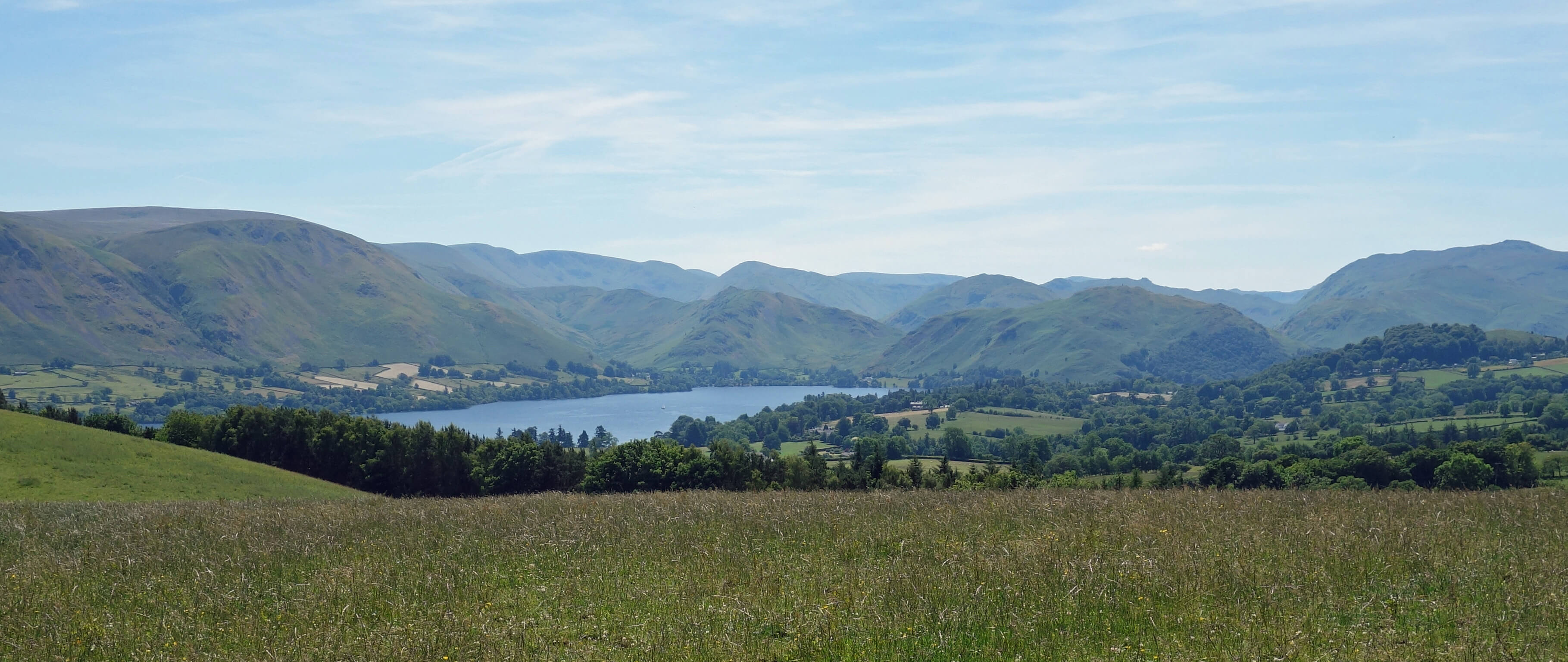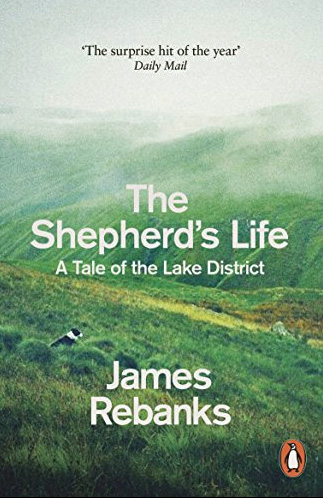
Home
Preamble
Index
Areas
Map
References
Me
Drakkar
Saunterings: Walking in North-West England
Saunterings is a set of reflections based upon walks around the counties of Cumbria, Lancashire and
North Yorkshire in North-West England
(as defined in the Preamble).
Here is a list of all Saunterings so far.
If you'd like to give a comment, correction or update (all are very welcome) or to
be notified by email when a new item is posted - please send an email to johnselfdrakkar@gmail.com.
17. Sheep-Wrecked Matterdale?
Pooley Bridge has a new bridge. It’s only a temporary one but that’s better than no bridge at all.
It was installed quickly to replace the fine 1764 bridge that was washed away in Storm Desmond of 2015.
However, the design for a rather splendid
new bridge
has been released and it is hoped that it will be
erected in 2019, although Pooley Bridge may be again without a bridge for nine months while it is erected.

Ullswater from Pooley Bridge
From Pooley Bridge I walked to Maiden Castle. This is, of course, not as impressive as the Dorset Maiden Castle. In fact,
it’s just a circular mound that wouldn’t get a second glance if it weren’t marked as ancient on the map. Somehow I
found myself on an Ullswater Way, and I had a chat with a couple of walkers about it:
“Do you know what this Ullswater Way is – it’s not marked on my map?”
“Yes, it’s a new path they set up after Storm Desmond washed away some old paths.”
“Oh – and where does it go?”
“All round Ullswater.”
“That’s a long way.”
“Yes, twenty miles. We’re aiming to walk it today.”
“That is a long way.”
“It’s not so far. You can see the end of Ullswater just over there.”
That ‘end of Ullswater’ was in fact just the bay at Howtown, at the first bend of Ullswater.
Most of Ullswater couldn’t be seen. Before I could say anything she added:
“But there’s always the steamer back if necessary.”
 Right: part of Ullswater.
Right: part of Ullswater.
I had a feeling it would be necessary. It was a hot day – much too hot for a twenty-mile walk. My aim was more
modest – to get to the top of Little Mell Fell (505 metres) in order to gain a view of Matterdale.
Matterdale is the home of James Rebanks whose acclaimed The Shepherd’s Life was published in 2015. This book portrays
in vivid and elegant prose what life is like for a Lake District shepherd. It is, however, more than a book about being
a shepherd: it is also a book for being a shepherd. He argues for the importance of sheep-farming within the Lake District’s
cultural and natural heritage. To this end, he enrols the concepts of ‘shepherd’ and ‘tradition’ that are, like motherhood,
inherently a good thing that it is difficult to argue against.
 The concept of ‘shepherd’ owes more to the metaphor than to the activity itself. It has religious overtones. We are
all members of a flock being shepherded on the path towards righteousness. There are many Churches of the Good Shepherd.
There used to be swineherds but there is no Church of the Good Swineherd. The Lord is not my swineherd. Of course,
shepherding is an arduous activity requiring detailed knowledge passed down through centuries. That does not make it inherently
virtuous, no more than it does for, say, mining or sea-fishing, although we may have the utmost respect for those who carry it out.
We should note also the ‘The’ in Rebanks’s book title. He is not describing his life but presumes to speak for the life of all
shepherds. Whether the work of all shepherds is so similar I cannot say but I doubt that many shepherds are Oxford-educated,
UNESCO consultants, authors and twitterers, as Rebanks is.
The concept of ‘shepherd’ owes more to the metaphor than to the activity itself. It has religious overtones. We are
all members of a flock being shepherded on the path towards righteousness. There are many Churches of the Good Shepherd.
There used to be swineherds but there is no Church of the Good Swineherd. The Lord is not my swineherd. Of course,
shepherding is an arduous activity requiring detailed knowledge passed down through centuries. That does not make it inherently
virtuous, no more than it does for, say, mining or sea-fishing, although we may have the utmost respect for those who carry it out.
We should note also the ‘The’ in Rebanks’s book title. He is not describing his life but presumes to speak for the life of all
shepherds. Whether the work of all shepherds is so similar I cannot say but I doubt that many shepherds are Oxford-educated,
UNESCO consultants, authors and twitterers, as Rebanks is.
Rebanks is on shaky ground relying on ‘tradition’ to justify the continuation of sheep-farming. He points out that
sheep-farming has been carried out in the Lake District for millennia and that his own family has farmed for generations.
No doubt the core of sheep-farming has continued much the same but the detail has evolved and the job now is surely very
different to what it was a thousand years ago. Even in the mere 67 years since the National Park was established the number
of sheep in the Lake District has doubled and the number of cattle has halved. Not long ago I expect almost every small-holding
had a pig: today we never see one. The rural traditions of thatching, charcoal-making, blacksmithing, and so on have all but
disappeared. My father made shoes, along with 10,000 other people in Norwich. Norwich had a tradition for shoe-making.
Now nobody makes shoes there. Are shoes less important than sheep? Is sheep-farming
intrinsically different to all the other
traditions that have gone?
Our governments think so. As Rebanks barely acknowledges in his book, sheep-farming is subsidised. It would not
be viable otherwise. Since the public pays, it has a right to ask if it is money well spent. Some think not. For example,
George Monbiot
considers the Lake District to be a ‘sheep-wrecked wasteland’ of “wet deserts grazed down to turf and rock;
erosion gullies from which piles of stones spill; woods in which no new trees have grown for 80 years, as every seedling
has been nibbled out by sheep; dredged and canalised rivers, empty of wildlife and dangerous to the people living downstream;
tracts of bare mountainside on which every spring is a silent one.”
However, visitors to the Lake District seem to like it
just as it is, and looking down from Little Mell Fell I could understand why. The fields were in various stages of verdancy,
depending on when they were mown; there were trees-a-plenty, and I could see only a few sheep dotted about (I think most were
sheltering from the sun). It looked a picture. In fact, like the picture below. Monbiot might do better to apply his
argument to where the ravages of sheep are more apparent, as, for example, on the Howgills where sheep keep the grass
garden-lawn short and nibble any would-be tree, thereby increasing run-off and flooding. Also, on the western slopes of
Ingleborough we can see the marked difference between areas where sheep are excluded, enabling shrubbery and varieties of
wildlife to flourish, and areas of monotonous, sheep-cropped grass.

Matterdale from Little Mell Fell, Blencathra to the right
This is a complicated topic and it will no doubt be debated in earnest when we leave the EU and have to decide for
ourselves how best to allocate farm subsidies. I felt a little weary walking down Little Mell Fell. It was probably the
hottest day of the year so far. I followed quiet lanes rather than worry about finding paths
across fields. They were indeed quiet for I saw one car and one bicycle during an hour’s steady walking. The tar on
the lanes was melting, and so was I. Eventually I got back to my old friend, the Ullswater Way. I am always a little relieved to be back on familiar
ground towards the end of a walk. It’s when you’re tired that mistakes are made, and I was really tired. I had an ice-cream
by the new Pooley Bridge. I felt I deserved it.

Back at Pooley Bridge
Date: June 25th 2018
Start: NY471244, Pooley Bridge (Map: OL5)
Route: W – Waterfoot, Maiden Castle – SW – Bennethead – W – Cove, The Hause – N –
Little Mell Fell – NW – Nabend – E – Sparket, crossroads – S – Bennethead – NE – Pooley Bridge
Distance: 9 miles; Ascent: 355 metres
Home
Preamble
Index
Areas
Map
References
Me
Drakkar
© John Self, Drakkar Press, 2018-

Top photo: The western Howgills from Dillicar;
Bottom photo: Blencathra from Great Mell Fell



 Right: part of Ullswater.
Right: part of Ullswater.
 The concept of ‘shepherd’ owes more to the metaphor than to the activity itself. It has religious overtones. We are
all members of a flock being shepherded on the path towards righteousness. There are many Churches of the Good Shepherd.
There used to be swineherds but there is no Church of the Good Swineherd. The Lord is not my swineherd. Of course,
shepherding is an arduous activity requiring detailed knowledge passed down through centuries. That does not make it inherently
virtuous, no more than it does for, say, mining or sea-fishing, although we may have the utmost respect for those who carry it out.
We should note also the ‘The’ in Rebanks’s book title. He is not describing his life but presumes to speak for the life of all
shepherds. Whether the work of all shepherds is so similar I cannot say but I doubt that many shepherds are Oxford-educated,
UNESCO consultants, authors and twitterers, as Rebanks is.
The concept of ‘shepherd’ owes more to the metaphor than to the activity itself. It has religious overtones. We are
all members of a flock being shepherded on the path towards righteousness. There are many Churches of the Good Shepherd.
There used to be swineherds but there is no Church of the Good Swineherd. The Lord is not my swineherd. Of course,
shepherding is an arduous activity requiring detailed knowledge passed down through centuries. That does not make it inherently
virtuous, no more than it does for, say, mining or sea-fishing, although we may have the utmost respect for those who carry it out.
We should note also the ‘The’ in Rebanks’s book title. He is not describing his life but presumes to speak for the life of all
shepherds. Whether the work of all shepherds is so similar I cannot say but I doubt that many shepherds are Oxford-educated,
UNESCO consultants, authors and twitterers, as Rebanks is.


